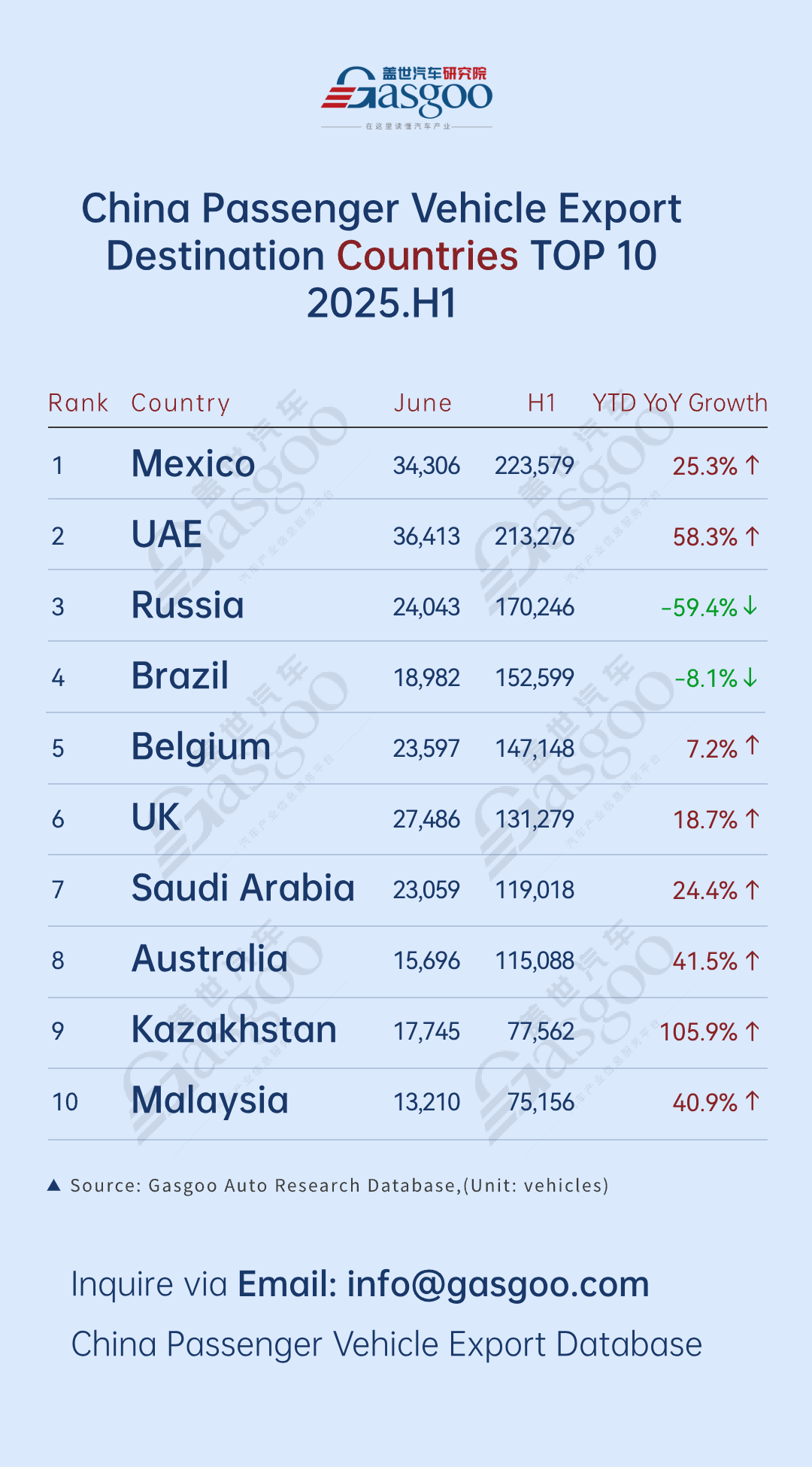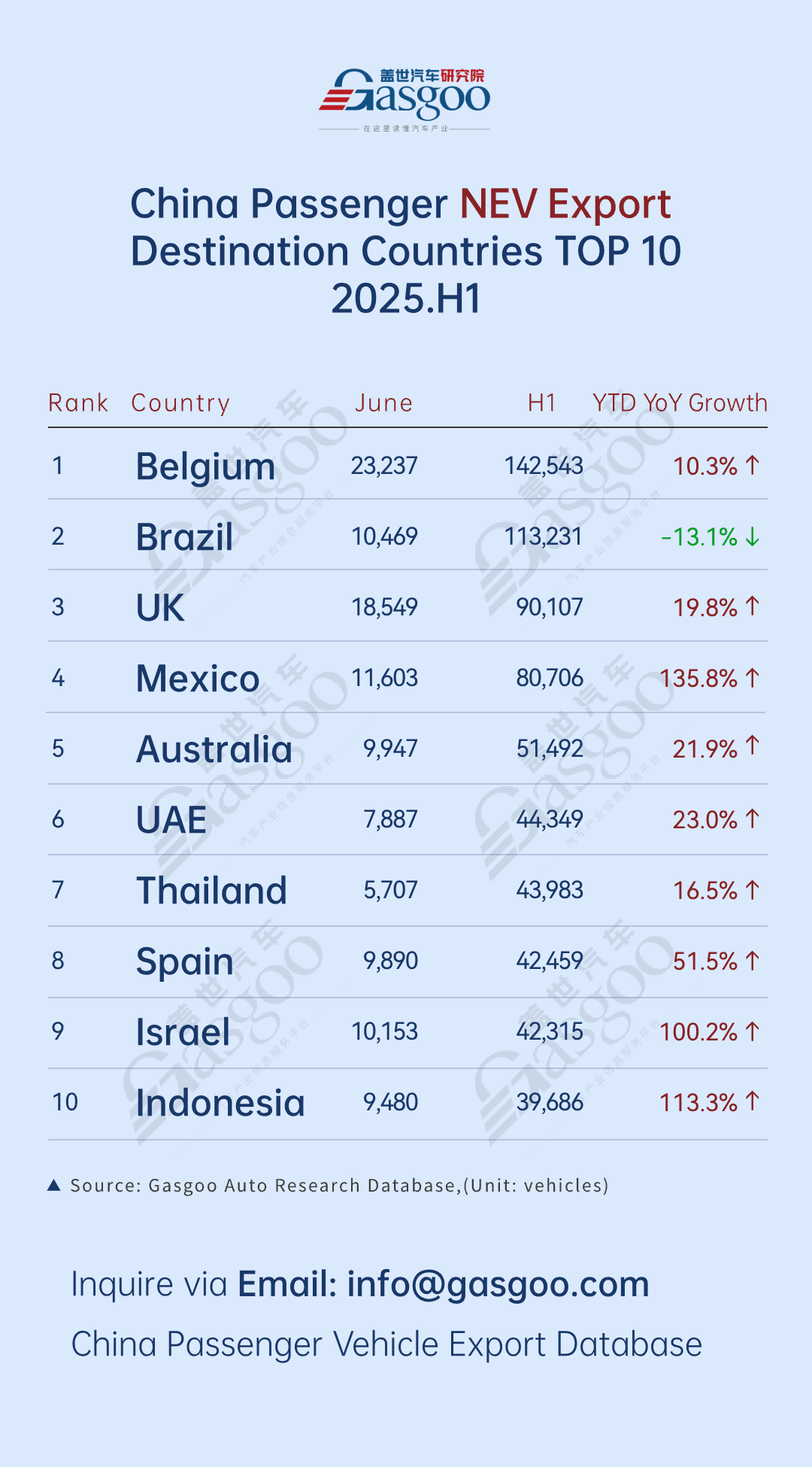Rooted localization in Latin America; Stabilization at high levels in Russia丨China’s passenger vehicle export overview in H1 2025
In the first half of 2025, China's passenger vehicle exports saw a clear shift toward new energy vehicle dominance, accompanied by increasing divergence across regional markets.
Mexico overtook Russia as the top export destination, with shipments rising 25.3% year-on-year to 224,000 units. The UAE (+58.3% YoY), Kazakhstan (+105.9% YoY), and Malaysia (+40.9% YoY) experienced explosive growth, while Russia (-59.4% YoY) and Brazil (-8.1% YoY) faced sharp declines due to stricter policy measures.
According to data compiled by the Gasgoo Automotive Research Institute, in the long term, deepening economic and trade cooperation between China and Europe, as well as between China and ASEAN, coupled with the development of regional production hubs, will drive Europe and Southeast Asia to become the key growth markets. This will lead to substantial increases in export volumes and market expansion. China's auto export growth model has shifted from "rising volume and prices" to "structural breakthroughs," with technology pathway choices and risk diversification capacity set to become decisive factors for success.
Top 10 destination countries by China's passenger vehicle exports
Mexico: 34,306 units in June and 223,579 units (+25.3% YoY) from January to June
UAE: 36,413 units in June and 213,276 units (+58.3% YoY) from January to June
Russia: 24,043 units in June and 170,246 units (−59.4% YoY) from January to June
Brazil: 18,982 units in June and 152,599 units (−8.1% YoY) from January to June
Belgium: 23,597 units in June and 147,148 units (+7.2% YoY) from January to June
UK: 27,486 units in June and 131,279 units (+18.7% YoY) from January to June
Saudi Arabia: 23,059 units in June and 119,018 units (+24.4% YoY) from January to June
Australia: 15,696 units in June and 115,088 units (+41.5% YoY) from January to June
Kazakhstan: 17,745 units in June and 77,562 units (+105.9% YoY) from January to June
Malaysia: 13,210 units in June and 75,156 units (+40.9% YoY) from January to June

In H1 2025, Mexico took the lead with 224,000 units shipped (+25.3% YoY). One of the key growth drivers was the deepening localization efforts by brands such as BYD. For example, BYD's Seagull and Song PLUS DM-i models have gained strong popularity in the Mexican market due to their high cost performance. Jorge Vallejo Sánchez, CEO of BYD Mexico, noted that the company has established nearly 100 dealerships across the country, a move expected to further strengthen its market leadership. He also revealed that in 2026, BYD plans to launch a new model in Mexico with a combined driving range of up to 2,000 kilometers.
The Middle East market also saw explosive growth over the same period. The UAE ranked second globally with 213,000 units (+58.3% YoY), while Saudi Arabia followed with 119,000 units (+24.4% YoY), supported by their ongoing electrification drives. Chinese automakers expanded rapidly in the region: BYD opened a flagship store in Dubai featuring models such as the YANGWANG U8; XPENG partnered with UAE dealer Ali & Sons; and Zeekr launched an experience center in Dubai's premium business district. Parallel exports also contributed significantly to the overall increase.
Russia stands out as a case of sharp market volatility. In H1 2025, China's passenger vehicle exports to Russia plunged 59.4% YoY to 170,246 units, primarily due to policy headwinds. Since October 2024, vehicle scrappage taxes have been raised by 70%–85%, with an additional 10%–20% hike scheduled annually from January 2025 onward. A high-interest lending environment has further dampened consumer demand, while growing concerns over the quality of Chinese vehicles—particularly their cold-weather adaptability—have forced manufacturers to accelerate technical upgrades. Even so, Chinese brands retained a relatively stable 58.7% share of Russia's passenger vehicle market in the first half, marking a shift from rapid export expansion to market stabilization.
In Europe, Belgium (144,000 units, +7.2% YoY) and the UK (131,000 units, +18.7% YoY) remained key battlegrounds for both battery electric vehicles (BEVs) and plug-in hybrid electric vehicles (PHEVs). In Southeast Asia, markets such as Malaysia (75,000 units, +40.9% YoY) posted rapid gains, leveraging KD assembly and localized production to accelerate market penetration.
Notably, Kazakhstan emerged as the standout dark horse, with exports surging 105.9% YoY to 78,000 units. Next, we take a closer look at this high-potential market.
Currently, Kazakhstan's new vehicle market holds significant potential. According to the leading local news outlet TENGRI NEWS, nearly 70% of vehicles in Kazakhstan are over 10 years old, creating strong demand for replacements.
Kazakhstan's automotive market remains dominated by internal combustion engine vehicles, but the electric vehicle segment is now in a phase of rapid expansion. Under the "Kazakhstan 2050 Strategy" and "Green Economy Concept of Kazakhstan," NEVs are targeted to account for more than 30% of new vehicle sales by 2030 and 50% by 2035. Since 2023, the government has designated NEVs as a priority investment sector, steadily increasing support through industrial planning, financial subsidies, and investment promotion. Key measures include purchase tax exemptions for NEVs and the rollout of a "Clean Mobility Infrastructure Program," which aims to install at least 2,000 public charging stations nationwide by 2026.
The Kazakhstan market saw a mix of new entrants and established brands advancing simultaneously. New players such as BYD Auto, Lynk & Co, GAC HYPTEC, and XPENG made their debut, while brands like Geely Auto and Changan Auto continued steady expansion through deepened local partnerships. Early in the year, BYD partnered with Astana Motors to hold product launch events in Almaty and Astana, officially entering Kazakhstan with flagship models including the Han EV and Song PLUS EV and DM-i. Starting in Q2 2025, Lynk & Co began sales of the Lynk 03 and Lynk 09 through its dealer Orbis Auto. GAC HYPTEC promoted its smart electric vehicle HL via local showroom displays and test-drive events, while XPENG remains in the market education phase with pilot sales through dealers. Notably, the Astana Motors Manufacturing Kazakhstan plant—invested in by the local automaker Astana Group—commenced production this year, initially producing four Chinese brands: Changan Auto, Chery Auto, Haval, and TANK models, marking a significant milestone in localizing production.
In addition to the entry of multiple Chinese brands into the market, the expansion of trade and transportation routes has become a key factor boosting Chinese passenger vehicle exports to Kazakhstan. Earlier this year, KTZ Express, a subsidiary of Kazakhstan Railways (KTZ), partnered with China Railway Container Transport Co., Ltd. (CRCT) to launch a new container transport service, inaugurating a China-Europe rail route that passes through the Middle Corridor. This route bypasses Russia, providing a direct link for Chinese goods to reach Europe.
Top 10 destination countries by China's new energy passenger vehicle exports
Belgium: 23,237 units in June and 142,543 units (+10.3% YoY) from January to June
Brazil: 10,469 units in June and 113,231 units (-13.1% YoY) from January to June
United Kingdom: 18,549 units in June and 90,107 units (+19.8% YoY) from January to June
Mexico: 11,603 units in June and 80,706 units (+135.8% YoY) from January to June
Australia: 9,947 units in June and 51,492 units (+21.9% YoY) from January to June
UAE: 7,887 units in June and 44,349 units (+23.0% YoY) from January to June
Thailand: 5,707 units in June and 43,983 units (+16.5% YoY) from January to June
Spain: 9,890 units in June and 42,459 units (+51.5% YoY) from January to June
Israel: 10,153 units in June and 42,315 units (+100.2% YoY) from January to June
Indonesia: 9,480 units in June and 39,686 units (+113.3% YoY) from January to June

NEV export rankings show steady growth in mature European markets. Belgium (142,543 units, +10.3% YoY) and the UK (90,107 units, +19.8% YoY) hold their positions under strict carbon emission policies, while Spain (42,459 units, +51.5% YoY) stands out as the fastest-growing market, driven by the extension of the MOVES III subsidy program.
Policy incentives in Latin America and the Middle East are unlocking substantial growth. Mexico (80,706 units, +135.8% YoY) leads the surge, driven by deeper local engagement from Chinese automakers such as BYD. Israel (42,315 units, +100.2% YoY) is benefiting from rising demand for battery technology cooperation, while the UAE (44,349 units, +23.0% YoY) is channeling "Vision 2030" infrastructure investments to accelerate the premiumization of Chinese vehicles.
However, higher import tariffs weighed on passenger vehicle exports to Brazil, which fell 13.1% in H1 2025 to 113,231 units. Since January 2024, the Brazilian government has been gradually reinstating tariffs on NEVs, with further increases scheduled each July. This July, tariffs on BEVs rose from 18% to 25%, while PHEVs increased from 20% to 28%.
The Southeast Asian market shows structural growth, led by Indonesia (39,686 units, +113.3% YoY) and Thailand (44,000 units, +16.5% YoY). This surge is mainly driven by tax incentives and accelerated localization of production.
Overall, Chinese automakers should stay alert in the short term to the cost impact of the EU's carbon border tax on exports and to trade policy volatility in markets such as Russia and Brazil. In the medium to long term, they must localize supply chains—such as BYD's plant in Brazil—and strengthen ESG compliance to align with global carbon neutrality goals. Meanwhile, leveraging policy opportunities in emerging markets like Indonesia and Mexico will be essential to shift from "export volume leadership" to "brand value enhancement."
Gasgoo not only offers timely news and profound insight about China auto industry, but also help with business connection and expansion for suppliers and purchasers via multiple channels and methods. Buyer service:buyer-support@gasgoo.comSeller Service:seller-support@gasgoo.com







